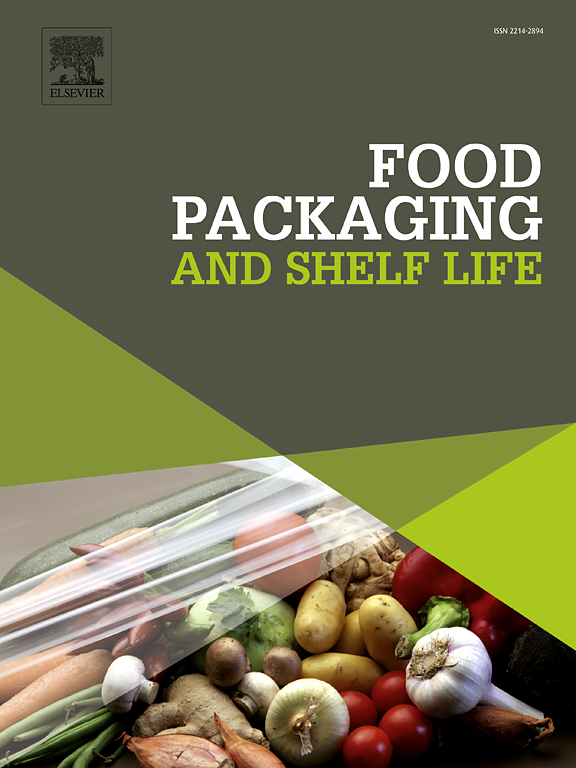Preparation and characterization of a pH-responsive smart film based on soy lipophilic protein/hydroxypropyl methylcellulose for salmon freshness monitoring and packaging
IF 8.5
1区 农林科学
Q1 FOOD SCIENCE & TECHNOLOGY
引用次数: 0
Abstract
Spoilage of aquatic products can lead to social problems such as environmental problems and health problems, and timely preparation of smart active packaging that can maintain and detect the freshness of aquatic products is crucial in the food field. For the first time, we developed a bilayer active packaging with soy lipophilic protein-hydroxypropyl methylcellulose (LP-HPMC) as the main film matrix and nanoemulsion (NE) prepared by LP (thyme essential oil and shikonin (SKN) as the oil phase) as the functional layer. The results have proven that adding NE enhances the water-blocking performance, thermal stability, antioxidant, and antibacterial properties of the LP-HPMC film. In addition, SKN and thyme essential oil had synergistic antioxidant and antibacterial effects. Compared with simply adding SKN, the NE film showed excellent indicating stability for pH and ammonia. When applied to salmon, the bilayer film had a better antimicrobial effect than the single-layer film due to its unidirectional release, which reduced microbial growth more effectively and monitored the freshness of the salmon through the discoloration effect. The color change process of the bilayer film attached to salmon of different freshness was recorded, and deep machine learning was performed using the VGG-16 model to quickly identify the "fresh" and "spoiled" salmon. This kind of multi-functional active packaging prepared based on pure natural substances has excellent prospects for preserving the freshness of aquatic products.
三文鱼新鲜度监测与包装用大豆亲脂蛋白/羟丙基甲基纤维素ph响应智能膜的制备与表征
水产品的腐败会导致环境问题、健康问题等社会问题,及时制备能够保持和检测水产品新鲜度的智能活性包装在食品领域至关重要。首次以大豆亲脂蛋白-羟丙基甲基纤维素(LP- hpmc)为主要膜基质,以LP(百里香精油和紫草素(SKN)为油相)为功能层制备纳米乳(NE)作为双层活性包装材料。结果表明,NE的加入提高了LP-HPMC膜的阻水性能、热稳定性、抗氧化和抗菌性能。此外,SKN与百里香精油具有协同抗氧化和抗菌作用。与单纯添加SKN相比,NE膜对pH和氨具有良好的指示稳定性。应用于鲑鱼时,由于双层膜的单向释放,其抗菌效果优于单层膜,更有效地减少了微生物的生长,并通过变色效果监测鲑鱼的新鲜度。记录附着在不同新鲜度鲑鱼上的双层膜的颜色变化过程,并利用VGG-16模型进行深度机器学习,快速识别“新鲜”和“变质”鲑鱼。这种以纯天然物质为原料制备的多功能活性包装在水产品保鲜方面具有良好的应用前景。
本文章由计算机程序翻译,如有差异,请以英文原文为准。
求助全文
约1分钟内获得全文
求助全文
来源期刊

Food Packaging and Shelf Life
Agricultural and Biological Sciences-Food Science
CiteScore
14.00
自引率
8.80%
发文量
214
审稿时长
70 days
期刊介绍:
Food packaging is crucial for preserving food integrity throughout the distribution chain. It safeguards against contamination by physical, chemical, and biological agents, ensuring the safety and quality of processed foods. The evolution of novel food packaging, including modified atmosphere and active packaging, has extended shelf life, enhancing convenience for consumers. Shelf life, the duration a perishable item remains suitable for sale, use, or consumption, is intricately linked with food packaging, emphasizing its role in maintaining product quality and safety.
 求助内容:
求助内容: 应助结果提醒方式:
应助结果提醒方式:


